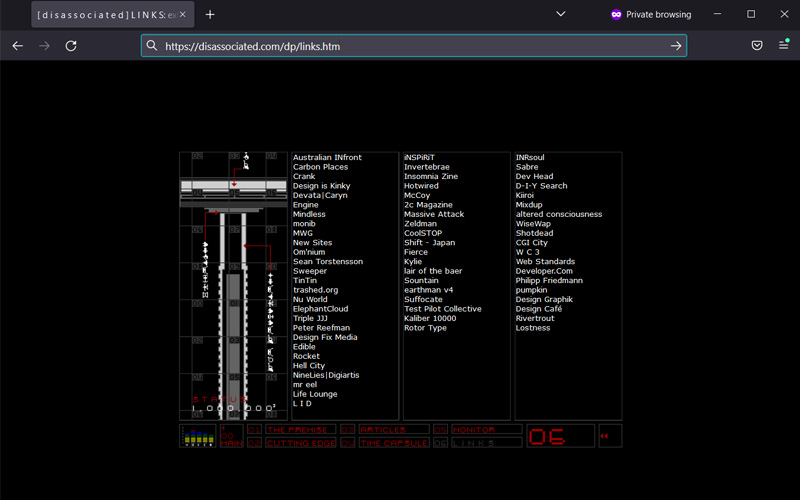A return to blogging RSS and blogrolls for content discovery
6 December 2022

While I’m not one hundred percent sure we’re entering the end-days of social media, some recent talk of a resurgence in blogging, and a return to using RSS for content discovery, is encouraging. It’s kind of the web I know the best. But like anyone else, I can be found on the socials, Twitter and Mastodon, among them. I should add I’m an introvert, so my socials are relatively quiet. And no, the irony of that last sentence is not lost on me.
I first acquired the disassociated domain name, disassociated.com.au, in 1997. disassociated.com, meanwhile, came along in early 2003. But not before someone else, who’d bought the name, tried to sell it to me in the early 2000’s. But way back in the day, a person’s own website was always regarded the central pivot of their online presence. Pages on the early socials, Friendster, MySpace, and later Twitter, Facebook, and Instagram, were always seen as “outposts”.
As a web person you had presences there, because everyone else did, but they were not core to your overall online presence. And for good reason. The socials might have been public web-spaces, but they were privately owned. Fall foul of their terms of service, and you stood have your account suspended, or worse, permanently shut down. Sometimes without recourse, because you were in the realm of someone else who was setting the rules.
But no problem, you still had your largely untouchable core online presence, your website, at your own domain, which was self-hosted somewhere. Until we didn’t. The socials became too easy to use. They were free, and no hosting charges needed to be paid. Having a self-hosted website required some degree — no matter how little — of technical competence. Twitter and Instagram offered unlimited server capacity, ease of use, and, through their sprawling memberships, a multitude of potential followers. No more drawn out wrangling with SEO to find eyes to see your stuff, an audience was already present. You simply (sort of) had to make yourself known to them.
But before SEO and the socials came along, audience building was a little trickier. Website owners and bloggers were required to put in a lot more groundwork. In the late 1990’s I was writing blog posts before blogging was a thing. Back then we called these blogs online journals. To make ourselves known to other people then, we might write an online journal post about them, while linking to their website at the same time. Another option was through guestbook comments.
Guestbooks were one of the earliest methods of interacting with a website owner, and were hugely popular in the late 1990’s. There were akin to the comments section of a blog post, although the discussion was confined to a single page on a website, where the guestbook was situated. Another tried and true way of making yourself known to other website owners was by way of a links page. Above is the links page that featured on disassociated in late 1999. I know a lot of those links are gone now, but later on I might click links and see who is still around.
I guess you could say website link pages evolved into the blogrolls that once adorned the main pages, usually a side bar (which I stopped using about ten years ago) of a blog, when blogs per se arrived. The search engines however bought about the demise of the old school blogroll, from around 2007 or 2008. They were concerned many of the inclusions to what were the favourite websites of the blogger, were paid placements. In those earlier days, the search engines were also opposed to the practice of linking to so-called “bad neighbourhoods.”
Bad neighbourhoods were seen as websites having little, or no relevance, to the subject matter of the blog that linked out to them. For instance, it was seen as bad practice for a blog focussed on film production to link to a blog focussed on baking cupcakes. That could only be downright suspicious, couldn’t it? Too bad if the cupcake blogger was the significant other of the film production blogger, interlinking was simply unacceptable, and might earn you a slap down from a search engine.
Hopefully those days are behind us. The web is too vast and diverse a place for anyone to stay in their own lane. But blogrolls have been making a comeback. Not so much on individual blogs, but in the form of a number of aggregator websites, which are focused on content discovery, and the work of outstanding writers and bloggers. Chief among them are feedle, Blogroll, ooh.directory, and FeedLand, which is a feeds repository.
As I wrote on Twitter recently, “search engines are great for finding resources on topics of interest but scrolling through lists of blogs and randomly spotting something compelling is plain fun”. I for one am hopeful of a blogging renaissance, and other ways of discovering content, far from the shadows of the social media giants.
RELATED CONTENT
